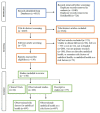Describing and Characterizing the Literature Regarding Umbilical Health in Intensively Raised Cattle: A Scoping Review
- PMID: 35737340
- PMCID: PMC9229987
- DOI: 10.3390/vetsci9060288
Describing and Characterizing the Literature Regarding Umbilical Health in Intensively Raised Cattle: A Scoping Review
Abstract
The objective of this scoping review was to describe and characterize the existing literature regarding umbilical health and identify gaps in knowledge. Six databases were searched for studies examining umbilical health in an intensively raised cattle population. There were 4249 articles initially identified; from these, 723 full text articles were then screened, with 150 articles included in the review. Studies were conducted in the USA (n = 41), Brazil (n = 24), Canada (n = 13), UK (n = 10), and 37 additional countries. Seventeen were classified as descriptive, 24 were clinical trials, and 109 were analytical observational studies. Umbilical outcomes evaluated in descriptive studies were infection (n = 11), parasitic infection (n = 5), and hernias (n = 2). Of the clinical trials, only one examined treatment of navel infections; the remainder evaluated preventative management factors for navel health outcomes (including infections (n = 17), myiasis (n = 3), measurements (n = 5), hernias (n = 1), and edema (n = 1)). Analytical observational studies examined risk factors for umbilical health (n = 60) and umbilical health as a risk factor (n = 60). Studies examining risk factors for umbilical health included navel health outcomes of infections (n = 28; 11 of which were not further defined), hernias (n = 8), scoring the navel sheath/flap size (n = 16), myiasis (n = 2), and measurements (n = 6). Studies examining umbilical health as a risk factor defined these risk factors as infection (n = 39; of which 13 were not further defined), hernias (n = 8; of which 4 were not further defined), navel dipping (n = 12), navel/sheath scores as part of conformation classification for breeding (n = 2), measurements (n = 3), and umbilical cord drying times (n = 2). This review highlights the areas in need of future umbilical health research such as clinical trials evaluating the efficacy of different treatments for umbilical infection. It also emphasizes the importance for future studies to clearly define umbilical health outcomes of interest, and consider standardization of these measures, including time at risk.
Keywords: cattle; morbidity; navel; omphalitis; umbilicus.
Conflict of interest statement
The authors declare no conflict of interest.
Figures





References
-
- USDA National Animal Heath Monitoring System. [(accessed on 3 January 2021)];2007 Available online: https://www.aphis.usda.gov/aphis/ourfocus/animalhealth/monitoring-and-su...
-
- Urie N.J., Lombard J.E., Shivley C.B., Kopral C.A., Adams A.E., Earleywine T.J., Olson J.D., Garry F.B. Preweaned heifer management on US dairy operations: Part V. Factors associated with morbidity and mortality in preweaned dairy heifer calves. J. Dairy Sci. 2018;101:9229–9244. doi: 10.3168/jds.2017-14019. - DOI - PMC - PubMed
-
- Waltner-Toews D., Martin S., Meek A. Dairy calf management, morbidity and mortality in Ontario Holstein herds. IV. Association of management with mortality. Prev. Vet. Med. 1986;4:159–171. doi: 10.1016/0167-5877(86)90020-6. - DOI
Publication types
Grants and funding
LinkOut - more resources
Full Text Sources

